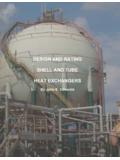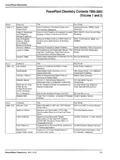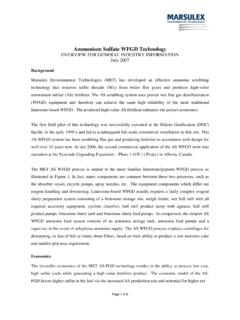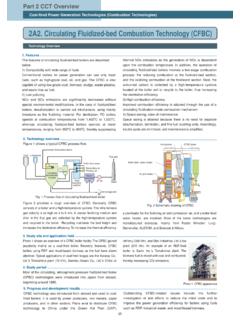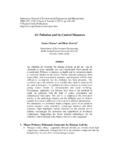Transcription of Power Plant Carbon Capture with CHEMCAD - …
1 Power Plant Carbon Capture with CHEMCAD11490 Westheimer Road, Suite 900 Houston, TX 77077 USA Voice FAX Toll-free 031109 Engineering advanced Page 1 Background 1, L 2 The worldwide focus on clean Power generation and Carbon Capture has increased the importance of the associated technologies, which involve two distinct approaches, namely pre-combustion and post-combustion Carbon Capture . In pre-combustion CO2 Capture , fuel is gasified by applying heat under pressure in the presence of steam and air and/or oxygen to form synthetic gas (Syngas). CO2 is then captured from the Syngas, before being mixed with air in a combustion turbine, resulting in the CO2 being relatively concentrated and at a high pressure. In post-combustion CO2 Capture , mainly, pulverized coal is burnt in air to raise steam. CO2 is exhausted in the flue gas at atmospheric pressure and concentrations of 10-15% v/v.
2 This process is more challenging due to the low pressure and dilute CO2 concentration resulting in a high volume of gas having to be treated. Also trace impurities in the flue gas tend to reduce the effectiveness of the CO2 absorbing processes and compressing the captured CO2 from atmospheric pressure to pipeline pressure represents a large parasitic load. Another post-combustion Capture technology, oxy-combustion, involves combustion of the fuel with near pure oxygen resulting in a flue gas stream of higher CO2 concentration. This technology relates more to combustion, and is not discussed further in this paper. When CO2 is captured, Power station generating efficiency is significantly reduced. Therefore a Power cycle with a high thermal efficiency is essential to ensure an acceptable outcome. Power cycle efficiency is continually being improved by increasing the steam temperature and pressure; this development is limited by the availability of suitable alloys.
3 Historical Trend in Boiler Operation (Note: water PC = 221 bar, TC = 374 C) Pressure Temperature Efficiency Operation Year bar C % Subcritical 1960 - 1970 166 540 38 to 42 Supercritical 1970 - 1990 240 566 44 Ultra supercritical 1990 - present 310 600 49 Ultra supercritical (USC), once-through utility (OTU) operation is considered to be the best option for Clean Coal Technology . USC operation reduces the CO2 emissions and therefore improves the economics of Carbon Capture and sequestration (CCS). Pre-combustion and post-combustion CCS methods are similar, in that both require significant Power for blowers, pumps and compressors. Studies are indicating parasitic Power in the range 15 to 25% with the technology, Plant layout, pressure drop, compressor operation, transportation, and sequestration configurations each having a significant effect. Crucial to CCS economics is the optimization of the heat integration circuits and the minimization of CO2 stripping steam to reduce the impact on Power Plant parasitic Power .
4 CO2 is present at much higher concentrations in Syngas than in post-combustion flue gas, so CO2 Capture should be less expensive for pre-combustion than for post-combustion Capture . However, there are few gasification plants in full-scale operation, and capital costs are higher than for conventional pulverized coal plants . Process simulators are playing an increasingly important role in finding the optimum economic solutions. CHEMCAD is being used in modeling pre-combustion and post-combustion processes and has developed thermodynamics specifically for the pre-combustion and compression technologies. Power Plant Carbon Capture with CHEMCAD11490 Westheimer Road, Suite 900 Houston, TX 77077 USA Voice FAX Toll-free 031109 Engineering advanced Page 2 Pre-combustion Carbon Capture In pre-combustion CC, the fuel will be either natural gas or gasified hydrocarbon feedstock.
5 If natural gas, it is converted into CO and H2 by auto thermal reforming (ATR) and then CO is converted into CO2 by the shift reaction. If hydrocarbon (coal or heavy oil), it is gasified in the presence of steam and air or oxygen at a high temperature and pressure, followed by the shift reaction to form CO2 , H2, COS and other gaseous compounds, depending on the hydrocarbon make-up. Appendix I A key part of this technology is the removal of CO2 and H2S (if present) from the Syngas by absorption in a physical solvent. The captured CO2 can then be processed or compressed and sequestered in a suitable reservoir. Proven technology includes the Selexol process that uses a solvent, which is a mixture of dimethyl ethers of polyethylene glycol. Dow Chemical Company retains the gas processing expertise, which is offered under license. Clariant GmbH offer an equivalent solvent, available from their Genosorb range.
6 Appendix II ATR reaction: 2CH4 + O2 + H2O 5H2 + CO (200-600 psi, 815-925 C) Shift reaction: CO + H2O H2 + CO2 Gasifier main reaction: C + H2O H2 + CO COS hydrolysis COS + H2O CO2 + H2S Steam Steam Air or O2 Natural Gas ATR H2 Generation Shift Reaction Gas Turbine Selexol Absorbers CO2 Compress CO2 Syngas Plant Combined Cycle with Carbon Capture CO2 Stripper Steam Power CO2/H2 CO/H2 H2 ATR Auto Thermal Reforming CO/H2 COS/H2S Steam Air or O2 Coal Heavy Oil Gasifier & Heat Recovery COS Hydrolysis & Shift Gas Turbine CO2 Compress CO2 Integrated Gasification Combined Cycle (IGCC) with Carbon Capture Steam Power CO2 Stripper H2 SteamCO2 /H2/H2S Selexol Absorbers H2S Power Plant Carbon Capture with CHEMCAD11490 Westheimer Road, Suite 900 Houston, TX 77077 USA Voice FAX Toll-free 031109 Engineering advanced Page 3 Post-combustion Carbon Capture The typical fuel is either natural gas or pulverized coal.
7 Appendix I When natural gas, it is combusted in a gas turbine, and when coal, it is combusted in a steam boiler. Alternative fuels, such as biomass and wood chippings, are now starting to be used. Key parts of this technology are Flue Gas Desulfuriztaion (FGD) to remove SO2(if present) by spray scrubbing with limestone, particulate removal by Electrostatic Precipitator (ESP), direct contact cooling (DCC) with circulating water and reactive absorption of CO2 using inhibited amine blends Appendix III. The captured CO2 is then desorbed from the rich amine by steam stripping and then compressed for transfer and sequestration in a suitable reservoir. A CCGT set has a gas turbine-generator, a waste heat boiler followed by a steam turbine-generator. The combined cycle Power Plant (CCPP) fuel is usually natural gas, although fuel oil or Syngas are being used.
8 The CCPP can have single-shaft or multi-shaft configurations. The single-shaft has one gas turbine, one steam turbine, one generator and one Heat Recovery Steam Generator (HRSG). The multi-shaft has one or more gas turbine-generators and HRSGs that supply steam to a separate single steam turbine-generator. Power Steam Gas Turbine Heat Recover Steam Gen Steam Turbine Amine Absorbers CO2 Stripper CO2 Compress Natural Gas CO2 Natural Gas Fired Combined Cycle with Carbon CaptureFlue Gas Steam Flue Gas Coal Preparation Boiler Steam Turbine NOx Removal Flue Gas De-sulfurization ESP & DCCA mine Absorbers CO2 Stripper CO2 Compress Coal Feed CO2 Pulverized Coal Fired with Carbon CapturePower CaSO4 CaCO3 ESP Electrostatic Precipitator DCC Direct Contact Cooler Power Plant Carbon Capture with CHEMCAD11490 Westheimer Road, Suite 900 Houston, TX 77077 USA Voice FAX Toll-free 031109 Engineering advanced Page 4 Thermodynamics Summary Appendices II, III & IV The CHEMCAD flowsheet will have a Global K Value Model selected, with individual UnitOps having Local K Value Model set to suit the specific process.
9 The Global K Value Models used in CHEMCAD are summarized below: Pre-combustion absorption and desorption special PSRK gas/physical solvent Flue gas desulfurization (FGD) gypsum process - electrolyte option with NRTL Flue gas desulfurization (FGD) Linde Solinox process - special PSRK Direct contact cooling (DCC) - Ideal vapor pressure - set as local K-value Post-combustion absorption and desorption at atmospheric pressure - AMINE Compression - Benedict Webb Ruben Starling (BWRS) with CO2 parameters For example, with pre-combustion absorption, flash, and compression, we would have: Global K-value Special PSRK and local K-value - BWRS for compression The global enthalpy models used are AMINE for post-combustion absorption and desorption at atmospheric pressure and latent heat for all other cases. Pre-combustion Absorption and Desorption 18, Appendix II The SELEXOL process is a well-proven, stable acid gas removal system based on the use of a dimethyl ether of polyethylene glycol as a physical solvent involving no chemical reaction.
10 The favorable physical solubilities of the acid gases relative to the other light gases demonstrate the suitability of SELEXOL for selective removal of H2S and for capturing CO2. The process is designed to take advantage of the solubility difference of H2S and CO2. The solubilities shown in the Table are for single components only and are approximate for multi-component systems. Selexol Solvent Relative Solubility of Gases Ref. 18 Components Solubility Ratio H2 (Least soluble) N2 CO CH4 CO2 75 COS 175 H2S 670 CH3SH 1,700 SO2 7,000 H2O 55,000 HCN (most soluble) 95,000 SELEXOL is now included in the CHEMCAD library component database.
